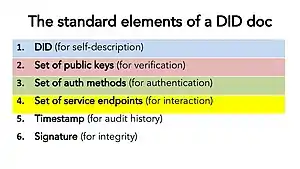Decentralized identifier
Decentralized identifiers (DIDs) are a type of globally unique identifier that enables an entity to be identified in a manner that is verifiable, persistent (as long as the DID controller desires), and does not require the use of a centralized registry.[1] DIDs enable a new model of decentralized digital identity that is often referred to as self-sovereign identity or decentralized identity.[2] They are an important component of decentralized web applications.

(Piloting_with_EBSI_Webinar_2_Roadmap_Your_Pilot)(v1.01)-20.png.webp)
DID documents
A decentralized identifier resolves (points) to a DID document, a set of data describing the DID subject, including mechanisms, such as cryptographic public keys, that the DID subject or a DID delegate can use to authenticate itself and prove its association with the DID.[1]
DID methods
Just as there are many different types of URIs, all of which conform to the URI standard, there are many different types of DID methods, all of which must conform to the DID standard.[1] Each DID method specification must define:
- The name of the DID method (which must appear between the first and second colon, e.g., did:example:).
- The structure of the unique identifier that must follow the second colon.
- The technical specifications for how a DID resolver can apply the CRUD operations to create, read, update, and deactivate a DID document using that method.
The W3C DID Working Group maintains a registry of DID methods.[3]
Usage of DIDs
A DID identifies any subject (e.g., a person, organization, thing, data model, abstract entity, etc.) that the controller of the DID decides that it identifies. DIDs are designed to enable the controller of a DID to prove control over it and to be implemented independently of any centralized registry, identity provider, or certificate authority. DIDs are URIs that associate a DID subject with a DID document.[4] Each DID document can express cryptographic material, verification methods, and service endpoints to enable trusted interactions associated with the DID subject. A DID document might contain additional semantics about the subject that it identifies. A DID document might also contain the DID subject itself (e.g. a data model).[5][1] The European Union is exploring DIDs and commercial companies like World Mobile already use DIDs.[6][7]
Standardization efforts
The W3C DID Working Group[8] developed a specification for decentralized identifiers to standardize the core architecture, data model, and representation of DIDs.
The W3C approved the DID 1.0 specification as a W3C Recommendation on July 19, 2022.[1]
See also
References
- "Decentralized Identifiers (DIDs) v1.0". World Wide Web Consortium. Retrieved 2021-06-01.
- "Decentralized Identifiers (DIDs) v1.0" (PDF). European Commission. Retrieved 2021-06-01.
- "W3C DID Spec Registries". World Wide Web Consortium.
- "Decentralized Identifiers: Everything you need to know about the next-gen web ID tech". The Daily Swig | Cybersecurity news and views. 2022-07-08. Retrieved 2023-08-25.
- "A Primer for Decentralized Identifiers - An introduction to self-administered identifiers for curious people". w3c.github.io. Retrieved 2020-05-26.
- "European Blockchain Services Infrastructure (EBSI)". European Commission. Retrieved 27 March 2023.
- "Decentralised Identifiers: An Introduction". worldmobile.io. Retrieved 27 March 2023.
- "W3C DID Working Group". World Wide Web Consortium. Retrieved 2020-07-25.